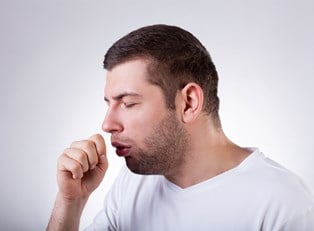Formerly a disease that afflicted infants and the very young, pertussis, or whooping cough, has largely been eradicated in the Unites States through use of modern vaccines. Now, though some infants still suffer symptoms, whooping cough is most prevalent among children over age 11, the elderly, and those with compromised immune systems. Whooping cough is highly communicable and spreads by droplets of body fluid expelled from an infected person, usually during a sneeze. Within two weeks of exposure, most infected persons will start to exhibit the symptoms of whooping cough. Since these symptoms surface only during coughing spasms, it is sometimes difficult to diagnose whooping cough; therefore, doctors customarily require a throat culture to determine if infected bacteria have invaded the pharynx. Untreated cases of whooping cough can develop into more serious conditions, such as pneumonia; therefore, infected individuals should seek medical attention as soon as they begin to exhibit symptoms.
Whooping Cough Symptoms
Classic whooping cough symptoms occur in two or three predictable phases. During the onset phase, whooping cough can mimic the symptoms of a common cold. However, unlike a cold, its duration can be up to 10 weeks. The cough exhibited during the onset phase is usually dry and mild and is accompanied by sneezing, runny nose, and watery eyes. After about two weeks in the first phase, victims enter the more prolonged second phase, which can last up to four weeks. For most, this proves to be the most trying phase since the cough becomes harder and may be accompanied by difficulty breathing, which accounts for the "whooping" noise from which the disease derives its common name. A coughing spasm may trigger vomiting; but after the spasm has passed, patients report feelings of normalcy until the next coughing spasm. Though most sufferers experience relief after phase two has passed, others continue to undergo intermittent flares of loud, hard coughing for several more weeks. Since pertussis can continue to prey on one's immune system for months at a time, it is best to seek medical treatment immediately so that normal activities may be resumed.
Whooping Cough Treatments
Thanks to Jonas Salk and his ground-breaking work with vaccines, most people will never experience this disease that threatened so many lives less than two centuries ago. In most industrialized countries, infants receive whooping cough vaccines within their first few months of life and receive follow-up boosters when they reach age 11. However, for those patients unfortunate enough to contract whooping cough anyways, a regimen of antibiotics is the usual recommendation, along with drinking fluids and regularly washing ones hands. Some have found that purchasing a good humidifier and cutting down on trigger substances--such as animal dander, dust or mold--also proves effective in minimizing symptoms. Adults and children aged one and older may gain some relief by sleeping on a side or their stomachs, rather than sleeping on their backs. Back sleeping can sometimes promote post-nasal drip, which can trigger a coughing spasm. Doctors do recommend that children under age one lie on their backs to avoid SIDS; however, consult your doctor if your child seems unable to rest in this position while he has whooping cough. After prescribing an antibiotic, doctors typically recommend that patients get plenty of bed rest and remain at home until five days after the beginning of antibiotic treatment. This precaution ensures that infected individuals do not end up contracting a more serious illness or spreading the disease to others.



